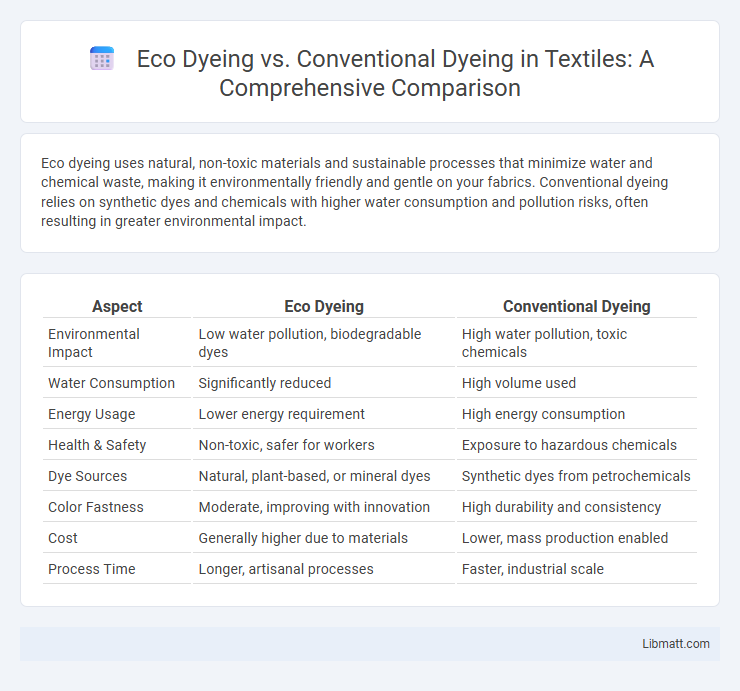Eco dyeing uses natural, non-toxic materials and sustainable processes that minimize water and chemical waste, making it environmentally friendly and gentle on your fabrics. Conventional dyeing relies on synthetic dyes and chemicals with higher water consumption and pollution risks, often resulting in greater environmental impact.
Table of Comparison
| Aspect | Eco Dyeing | Conventional Dyeing |
|---|---|---|
| Environmental Impact | Low water pollution, biodegradable dyes | High water pollution, toxic chemicals |
| Water Consumption | Significantly reduced | High volume used |
| Energy Usage | Lower energy requirement | High energy consumption |
| Health & Safety | Non-toxic, safer for workers | Exposure to hazardous chemicals |
| Dye Sources | Natural, plant-based, or mineral dyes | Synthetic dyes from petrochemicals |
| Color Fastness | Moderate, improving with innovation | High durability and consistency |
| Cost | Generally higher due to materials | Lower, mass production enabled |
| Process Time | Longer, artisanal processes | Faster, industrial scale |
Overview of Dyeing Methods
Eco dyeing utilizes natural dyes derived from plants, minerals, and other sustainable sources, minimizing environmental impact through reduced water consumption and lower chemical usage. Conventional dyeing often relies on synthetic dyes produced from petrochemicals, involving intensive water use and significant chemical effluent that contributes to pollution. The shift towards eco dyeing emphasizes biodegradable materials and energy efficiency, presenting a more sustainable alternative to traditional dyeing processes in the textile industry.
What is Eco Dyeing?
Eco dyeing is a sustainable textile coloring method that uses natural materials like plants, flowers, and minerals to create vibrant, biodegradable dyes without harmful chemicals. Unlike conventional dyeing, which relies on synthetic dyes and toxic substances, eco dyeing minimizes water pollution and energy consumption. This eco-friendly process supports organic waste reduction and promotes healthier ecosystems within the fashion and textile industries.
What is Conventional Dyeing?
Conventional dyeing is a textile coloring process that uses synthetic chemical dyes and large amounts of water, energy, and toxic chemicals to produce vibrant and consistent colors. This method often generates significant environmental pollution due to wastewater containing heavy metals, salts, and hazardous substances. Despite its widespread industrial use, conventional dyeing poses challenges related to sustainability and ecological impact.
Key Differences Between Eco Dyeing and Conventional Dyeing
Eco dyeing uses natural fibers and plant-based dyes, reducing chemical waste and water consumption compared to conventional dyeing, which relies heavily on synthetic dyes and toxic chemicals. The eco dyeing process emphasizes sustainability by minimizing environmental impact through biodegradable materials and low energy usage. Your choice of eco dyeing supports healthier ecosystems and safer working conditions in textile production.
Environmental Impact Comparison
Eco dyeing significantly reduces water consumption and chemical waste compared to conventional dyeing, which often involves toxic substances polluting waterways. The use of natural ingredients in eco dyeing minimizes carbon emissions and soil contamination, promoting sustainable textile production. Conventional dyeing processes generate higher levels of hazardous effluents and contribute more extensively to environmental degradation and resource depletion.
Health and Safety Considerations
Eco dyeing significantly reduces exposure to harmful chemicals commonly found in conventional dyeing processes, promoting a safer working environment and minimizing skin irritations, respiratory issues, and long-term health risks for workers. Conventional dyeing often involves toxic substances like heavy metals, formaldehyde, and synthetic dyes that pose serious health hazards and require strict handling protocols. Choosing eco dyeing methods supports your commitment to health and safety by fostering sustainable practices with non-toxic, biodegradable materials.
Color Fastness and Quality
Eco dyeing uses natural plant-based dyes that often provide gentler yet less consistent color fastness compared to conventional dyeing, which employs synthetic dyes engineered for vibrant, long-lasting hues. While conventional dyeing typically ensures higher uniformity and durability in fabric quality, eco dyeing offers a unique, artisanal appearance with subtle variations that may appeal to your preference for sustainable fashion. Choosing eco dyeing supports environmental health, although it may require careful handling to maintain optimal color quality over time.
Cost Analysis and Economic Viability
Eco dyeing generally incurs higher initial costs due to natural materials and longer processing times, but offers economic viability through reduced chemical expenses and lower wastewater treatment costs. Conventional dyeing presents lower upfront costs and faster production, yet faces escalating expenses from environmental compliance and waste disposal. You can achieve long-term savings and market differentiation by investing in eco dyeing techniques despite the initial financial outlay.
Trends in the Textile Industry
Eco dyeing is gaining momentum as a sustainable trend in the textile industry, driven by increasing consumer demand for environmentally friendly products and stricter regulations on chemical use. Conventional dyeing methods rely heavily on synthetic dyes and large quantities of water, contributing to pollution and resource depletion. You can support industry innovation by choosing eco-friendly dyeing processes that reduce environmental impact and promote circular fashion practices.
Future Prospects of Sustainable Dyeing
Eco dyeing leverages natural pigments and biodegradable mordants, significantly reducing water usage and toxic waste compared to conventional dyeing processes. Innovations in bio-based dyes and closed-loop water systems enhance sustainability, aligning with increasing consumer demand for environmentally responsible textiles. Your investment in eco dyeing technology supports a shift towards circular fashion, promising reduced ecological impact and compliance with evolving environmental regulations.
Eco dyeing vs Conventional dyeing Infographic

 libmatt.com
libmatt.com